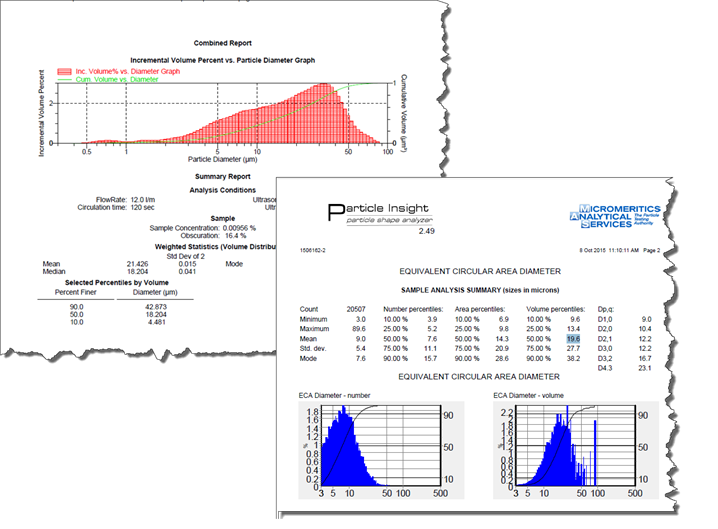 The Particle Insight Shape Module (PiSM) adds comprehensive particle shape analysis capability to laser diffraction and other size-only wet suspension technologies. Rather than determining only particle size information, the PiSM will report up to 30 different shape-related measures, including size, as well as images of each sample measured.
The Particle Insight Shape Module (PiSM) adds comprehensive particle shape analysis capability to laser diffraction and other size-only wet suspension technologies. Rather than determining only particle size information, the PiSM will report up to 30 different shape-related measures, including size, as well as images of each sample measured.
The PiSM was developed to be an add-one component to size-only measurement techniques. The PiSM is able to plumb into your existing system enabling the measurement of same aliquot of sample for both systems. Being that most techniques in the market assume that particles are spherical in nature when reporting results, having additional shape information as well as particles images in addition to results from current techniques enables the user to gain a better understanding of the particles and how they would perform in their final use.
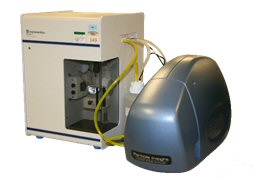
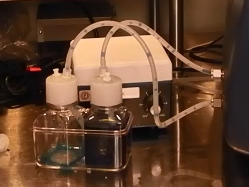 In certain situations it is important that the sample be fully enclosed and contained, as with hazardous materials, or “rare event detection”, where particle concentrations are very low and the sample needs to be protected from outside contamination. In these cases, you can use bottles designed for this purpose connected to the Shape Module, with positive pressure air as the fluid drive mechanism. View a short demo video of this method.
In certain situations it is important that the sample be fully enclosed and contained, as with hazardous materials, or “rare event detection”, where particle concentrations are very low and the sample needs to be protected from outside contamination. In these cases, you can use bottles designed for this purpose connected to the Shape Module, with positive pressure air as the fluid drive mechanism. View a short demo video of this method.
It is important to note that this is not a low resolution simplified shape analysis module. This is a fully functional high resolution dynamic image analysis system with high-end optics and robust software. In addition, the PiSM is configurable to match the specific size range and quality of your sample. Lens power is chosen based on the known size range.
Complementary to Laser Diffraction

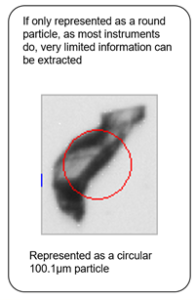 Not all particles are round. In fact, very few are in real life. Laser diffraction performs an indirect measurements of size. What this means is that what is being measured in laser diffraction is NOT the actual size of the particle but rather the diffracted angular light intensity that is scattered as a function of size. As a result, this method as well as many others used in industry, assume that particles are spherical in nature when reporting size information. The calculations rendered are based on what is known as Equivalent Spherical Diameter. If the particles being measured are, in fact, round in nature, this would be an accurate way of checking the size, however if they are not round, and most are not, then assuming they are round when looking at statistical results may lead the operator to believe that the particles will perform one way when in fact they will perform differently. For example, if a particle that is measured is assumed to be 100microns in diameter and this calculation is made assuming the particle is spherical, the operator may assume that the flow and mixing of these particles would be well dispersed and uniform in nature. However if the actual shape of the particle is far from being spherical in nature, then the performance of these particles would be drastically different. Particle sub-components may separate during transport and not blend well.
Not all particles are round. In fact, very few are in real life. Laser diffraction performs an indirect measurements of size. What this means is that what is being measured in laser diffraction is NOT the actual size of the particle but rather the diffracted angular light intensity that is scattered as a function of size. As a result, this method as well as many others used in industry, assume that particles are spherical in nature when reporting size information. The calculations rendered are based on what is known as Equivalent Spherical Diameter. If the particles being measured are, in fact, round in nature, this would be an accurate way of checking the size, however if they are not round, and most are not, then assuming they are round when looking at statistical results may lead the operator to believe that the particles will perform one way when in fact they will perform differently. For example, if a particle that is measured is assumed to be 100microns in diameter and this calculation is made assuming the particle is spherical, the operator may assume that the flow and mixing of these particles would be well dispersed and uniform in nature. However if the actual shape of the particle is far from being spherical in nature, then the performance of these particles would be drastically different. Particle sub-components may separate during transport and not blend well.
 Image Analysis performs a direct measurement of the particle. Unlike Laser Diffraction and other indirect measurement techniques, Image Analysis will take measurements of images of the actual particle. By doing this, calculations can be made to render many different measures about a particle. In the similar case shown above, the 100micron diameter particle, assuming it is round in nature, would have up to 30 additional
Image Analysis performs a direct measurement of the particle. Unlike Laser Diffraction and other indirect measurement techniques, Image Analysis will take measurements of images of the actual particle. By doing this, calculations can be made to render many different measures about a particle. In the similar case shown above, the 100micron diameter particle, assuming it is round in nature, would have up to 30 additional 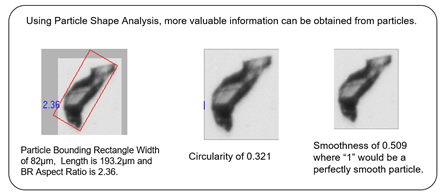 measurements calculated. This gives the user much more confidence to make correct assumptions of how their particles will perform.
measurements calculated. This gives the user much more confidence to make correct assumptions of how their particles will perform.
Data can be compared using the Particle Insight instrument software or by comparing printed reports.

